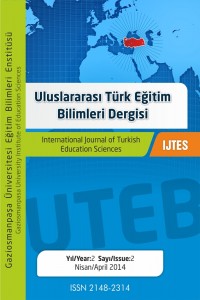Abstract
Word education continues from birth and until the end of life. In the first years of life too many words learned, this rate drops with age . While vocabulary developing randomly in first years of human, In elementary school and later education levels it evolves deliberately. The size of the vocabulary is closely related to the both ability to understand and communicate . The larger vocabulary size the beter in those capabilities. Therefore, vocabulary and vocabulary instruction is very important for success in schools and Professional life. In this experimental study the success of context-based vocabulary teaching technique was investigated . The study was designed as dependent groups with – pretest-application - posttest and T- test was performed using the SPSS program. For the study, the list of words and contextual editing list were developed and applied in the experiment. In the study, 98 primary school students were chosen as study group. According to the survey , context-based teaching technique is more efficient on the basis of success than traditional word teaching method. Some recommendations were made, such as, the program should include word lists by the lesson, level , class , and by degrees; national policy formulation should be created and oragnized in this matter.
References
- AKSAN, Doğan (1990). Her Yönüyle Dil. Ankara: TTK Yayınları.
- AKYOL, H. (1997), “Kelime Öğretimi”, Milli Eğitim, S.134, (Nisan-Mayıs-Haziran) ANDERSON, R.C.-NAGY, W.E. (1992), “The Vocabulary Conundrum”, American American Educator, 16 (4), s. 14-47
- BİEMİLLER, A., ve BOOTE, C. (2006). An effective method for building meaning vocabulary in primary grades. Journal of Educational Psychology, 98, 44–62
- BYRNES, J. P., ve WASİK, B. A. (2009). Language and literacy development: What educators need to know. New York, NY: Guilford
- COYNE, M. D., SİMMONS, D. C., KAME’ENUİ, E.J., ve Stoolmiller, M. (2004). Teaching vocabulary during shared readings: An examination of differential effects. Exceptionality, 12(3), 145–162.
- CUNNİNGHAM, A. E., ve STANOVİCH, K. E. (1998). What reading does for the mind. American Educator, 22(1 / 2), 8–15
- DEMİR, C., Türkçe/Edebiyat Eğitimi ve Kişisel Kelime Serveti, Millî Eğitim, (2006) 169, 207-226
- ELLEY, W.B. (1989), Vocabulary Acquisition from Listening to Stories. Reading Research Quarterly, 24, s. 174-187
Abstract
Kelime öğretimi doğumdan başlayarak hayatın sonuna kadar devam eder. Hayatın ilk yıllarında çok fazla sayıda kelime öğrenilirken, yaş ilerledikçe bu hız düşer. İlkokula gidene kadar aile ve yakın çevrede rastlantısal olarak gelişen kelime dağarcığı, eğitimle birlikte hem kasıtlı hem de yine rastlantısal olarak devam eder. Kelime dağarcığının büyüklüğü anlama ve anlatma yetenekleriyle yakından ilgilidir. Çok kelime bilenlerin bu yetenekleri daha fazla gelişmiştir. Bundan dolayı okul ve iş başarısında kelime dağarcığı ve kelime öğretimi çok önemlidir. Bu deneysel çalışmada bağlam temelli kelime öğretimi tekniğinin başarı üzerine etkisi araştırılmıştır. Bağımlı gruplar ön test-uygulama- son test olarak desenlenen çalışmada SPSS programı kullanarak T-testi uygulanmıştır. Bu çalışma için geliştirilen kelime listesi ve bağlamsal kurgulama deneye grubuna uygulanmıştır. Araştırmada 98 ilkokul öğrencisi ile çalışılmıştır. Araştırmanın sonuçlarına göre, bağlam temelli kelime öğretimi tekniği geleneksel yöntemlere göre –başarı temel alındığında- daha verimlidir. Programlara öğretilecek kelime listelerinin derse, düzeye, sınıfa ve dereceye göre eklenmesi, bu konuda Ulasal politika oluşturulması gibi öneriler getirilmiştir.
References
- AKSAN, Doğan (1990). Her Yönüyle Dil. Ankara: TTK Yayınları.
- AKYOL, H. (1997), “Kelime Öğretimi”, Milli Eğitim, S.134, (Nisan-Mayıs-Haziran) ANDERSON, R.C.-NAGY, W.E. (1992), “The Vocabulary Conundrum”, American American Educator, 16 (4), s. 14-47
- BİEMİLLER, A., ve BOOTE, C. (2006). An effective method for building meaning vocabulary in primary grades. Journal of Educational Psychology, 98, 44–62
- BYRNES, J. P., ve WASİK, B. A. (2009). Language and literacy development: What educators need to know. New York, NY: Guilford
- COYNE, M. D., SİMMONS, D. C., KAME’ENUİ, E.J., ve Stoolmiller, M. (2004). Teaching vocabulary during shared readings: An examination of differential effects. Exceptionality, 12(3), 145–162.
- CUNNİNGHAM, A. E., ve STANOVİCH, K. E. (1998). What reading does for the mind. American Educator, 22(1 / 2), 8–15
- DEMİR, C., Türkçe/Edebiyat Eğitimi ve Kişisel Kelime Serveti, Millî Eğitim, (2006) 169, 207-226
- ELLEY, W.B. (1989), Vocabulary Acquisition from Listening to Stories. Reading Research Quarterly, 24, s. 174-187
Details
| Primary Language | Turkish |
|---|---|
| Journal Section | Articles |
| Authors | |
| Publication Date | June 17, 2014 |
| Submission Date | June 17, 2014 |
| Published in Issue | Year 2014 Volume: 2014 Issue: 2 |

